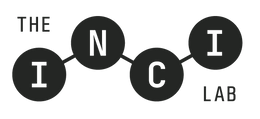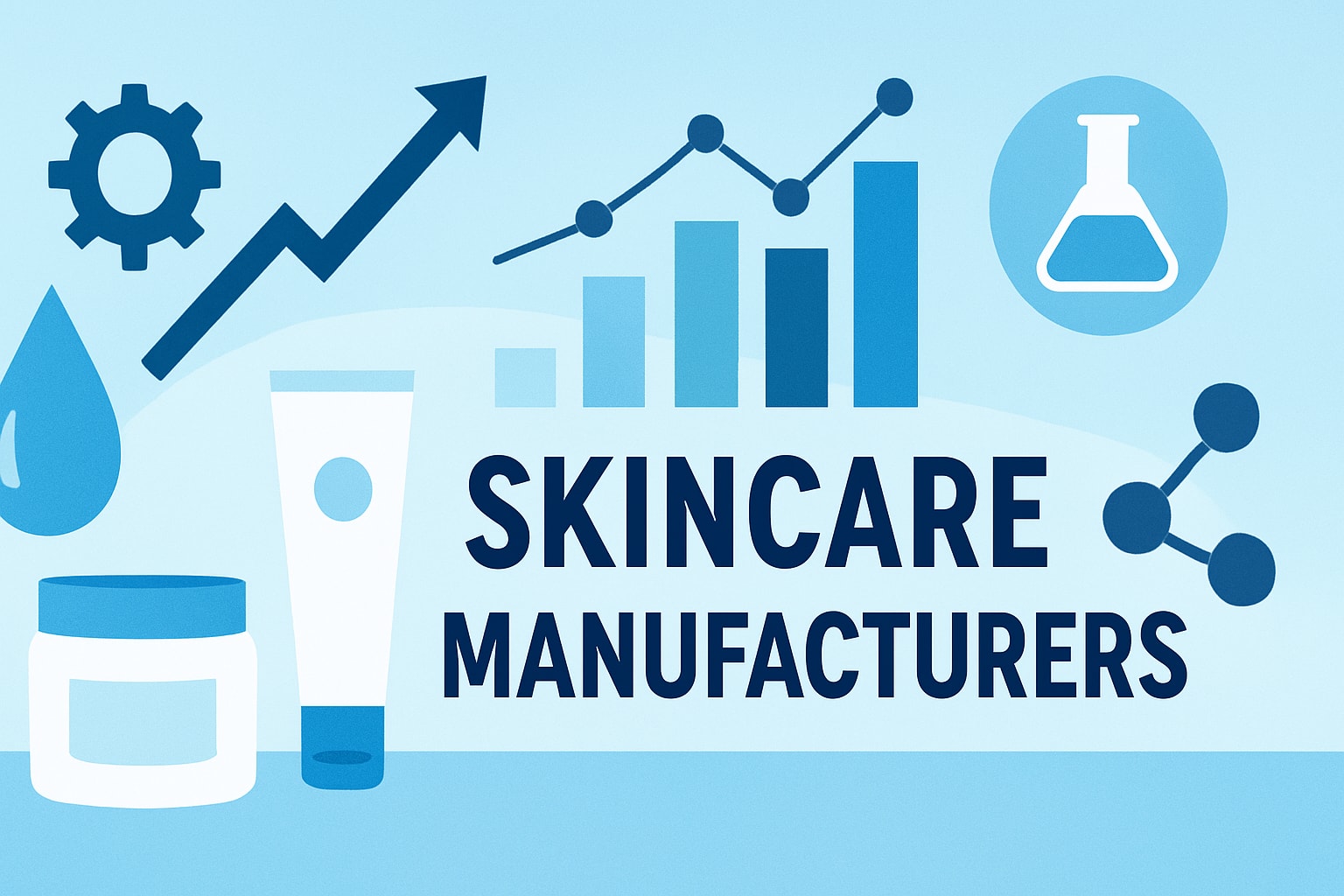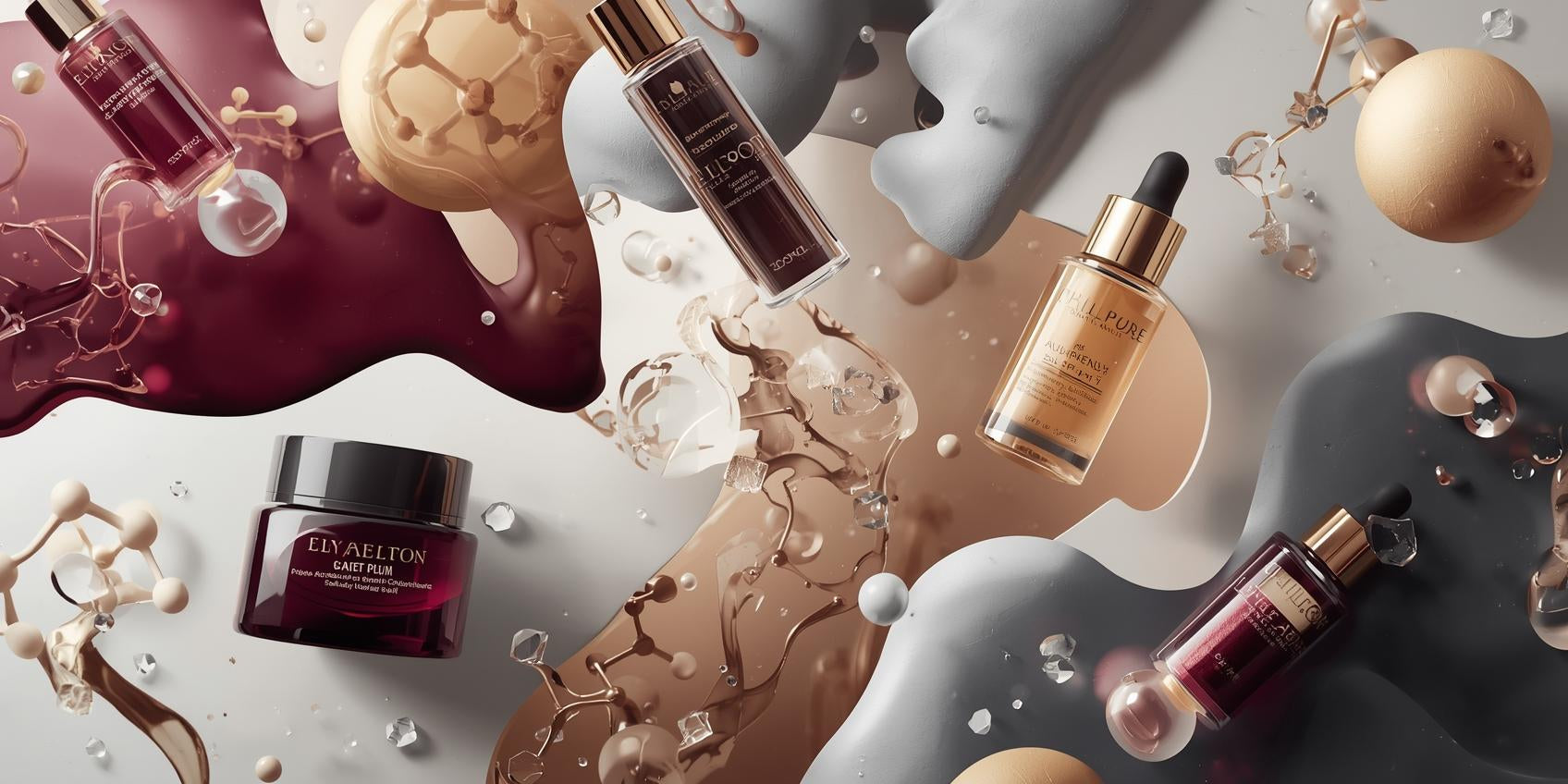The skincare industry is evolving at a remarkable pace as scientific breakthroughs and rising consumer expectations shape trends for 2025. New technologies, ingredient innovations, and an increased focus on safety and sustainability are transforming how products are created and used.
This essential guide to skincare formulation will empower you to navigate this dynamic landscape with confidence. You will discover the latest advancements, practical steps, and regulatory shifts that define modern product development.
As demand grows for personalized, high-performance products, understanding skincare formulation is more important than ever. Whether you are a formulator, entrepreneur, or skincare enthusiast, actionable insights await. Ready to master the fundamentals and stay ahead in 2025? Let us begin.
Understanding the Skincare Formulation Landscape in 2025
The skincare formulation landscape in 2025 reflects a fusion of scientific innovation, evolving consumer values, and global regulatory advancements. Brands and formulators must navigate a dynamic environment shaped by biotechnology, digital tools, and ethical demands.
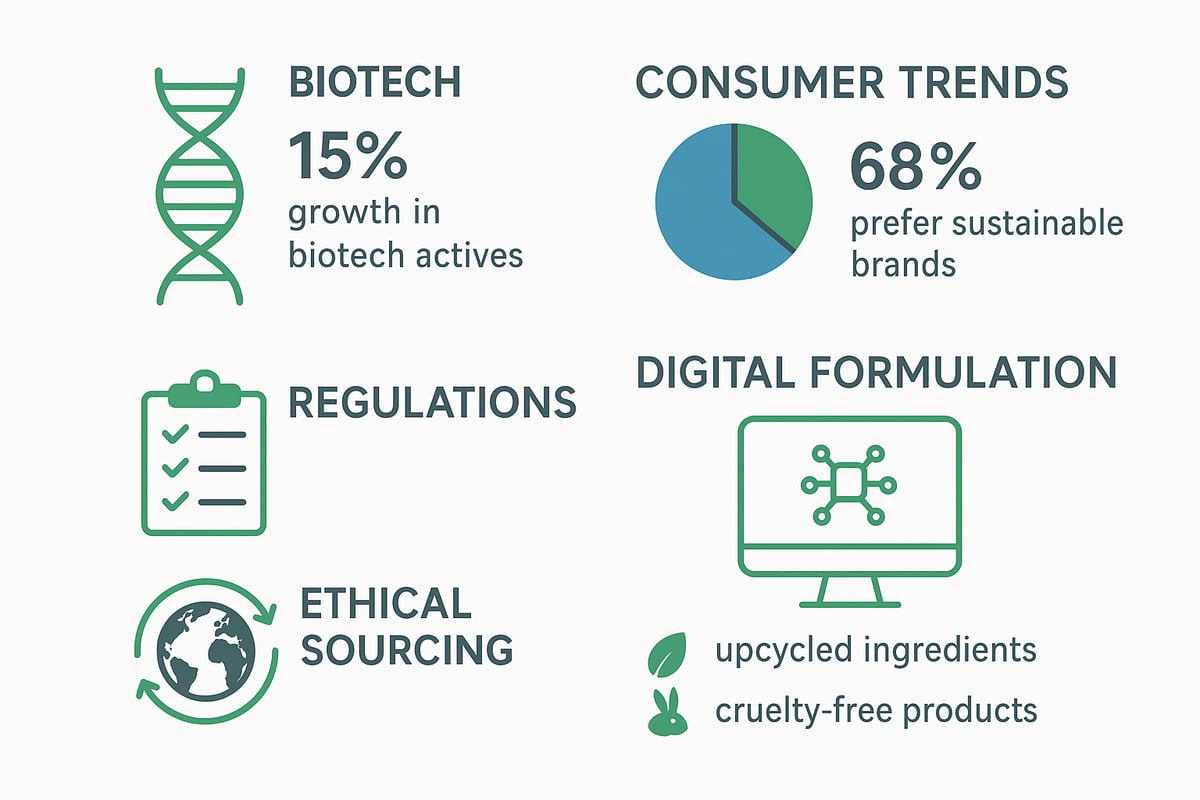
The Evolution of Skincare Science
Skincare formulation has entered a new era, propelled by breakthroughs in biotechnology and digital science. Lab-grown actives, bio-fermented ingredients, and AI-driven ingredient selection now define modern product development.
The rise of peptides and bio-fermented actives is particularly notable. According to industry projections, biotech-driven actives are set to grow by 15% in 2025. This shift is not only about novel ingredients but also about efficiency and safety in formulation.
Staying up to date with biotech-driven skincare innovations ensures that brands remain competitive and align with scientific best practices.
Consumer Trends and Market Demands
Consumers in 2025 expect more from their skincare formulation. The demand for personalized, clean, vegan, and cruelty-free products continues to rise. Microbiome-friendly and adaptogen-rich products are gaining traction as shoppers prioritize skin health and resilience.
Transparency and sustainability are no longer optional. Shoppers want to know the source of each ingredient and the impact on the environment. Brands that can clearly communicate these values see stronger loyalty.
- Personalized solutions
- Microbiome-focused products
- Clear ingredient sourcing
- Eco-conscious packaging
Regulatory and Compliance Updates
Global regulations are rapidly changing, directly impacting skincare formulation. New rules in the EU, FDA, and APAC regions require stricter limits on preservatives and more detailed allergen disclosures.
For example, recent updates mandate clearer labeling of potential allergens and the inclusion of comprehensive safety assessments. These changes make compliance essential for market access and for building consumer trust.
Staying ahead of regulatory shifts helps brands avoid costly recalls and ensures consumer safety remains a top priority.
The Role of Technology in Formulation
Technology is transforming skincare formulation from ideation to launch. Formulators now leverage sophisticated software and AI to predict ingredient compatibility and product stability.
Digital prototyping accelerates research and development, allowing for rapid iteration and reduced time to market. Platforms can simulate product performance, minimizing trial and error in the lab.
Embracing these tools not only streamlines formulation but also enables more innovative and effective products.
Sustainability and Ethical Sourcing
Sustainability is at the heart of modern skincare formulation. Brands focus on eco-friendly ingredients, upcycling, and transparent supply chains to meet ethical standards and consumer expectations.
Upcycled fruit extracts and biodegradable packaging are becoming industry norms. According to recent data, 68% of consumers prefer brands with strong sustainability commitments, making this a clear market advantage.
Responsible sourcing and circular practices not only reduce environmental impact but also strengthen brand reputation and consumer trust.
Core Ingredients and Their Functions in Modern Skincare
Modern skincare formulation relies on a strategic blend of essential ingredients, each playing a unique role in product performance and skin health. Understanding these core components is crucial for creating safe, effective, and innovative skincare products. Let’s explore the main categories and their contributions to advanced skincare formulation.
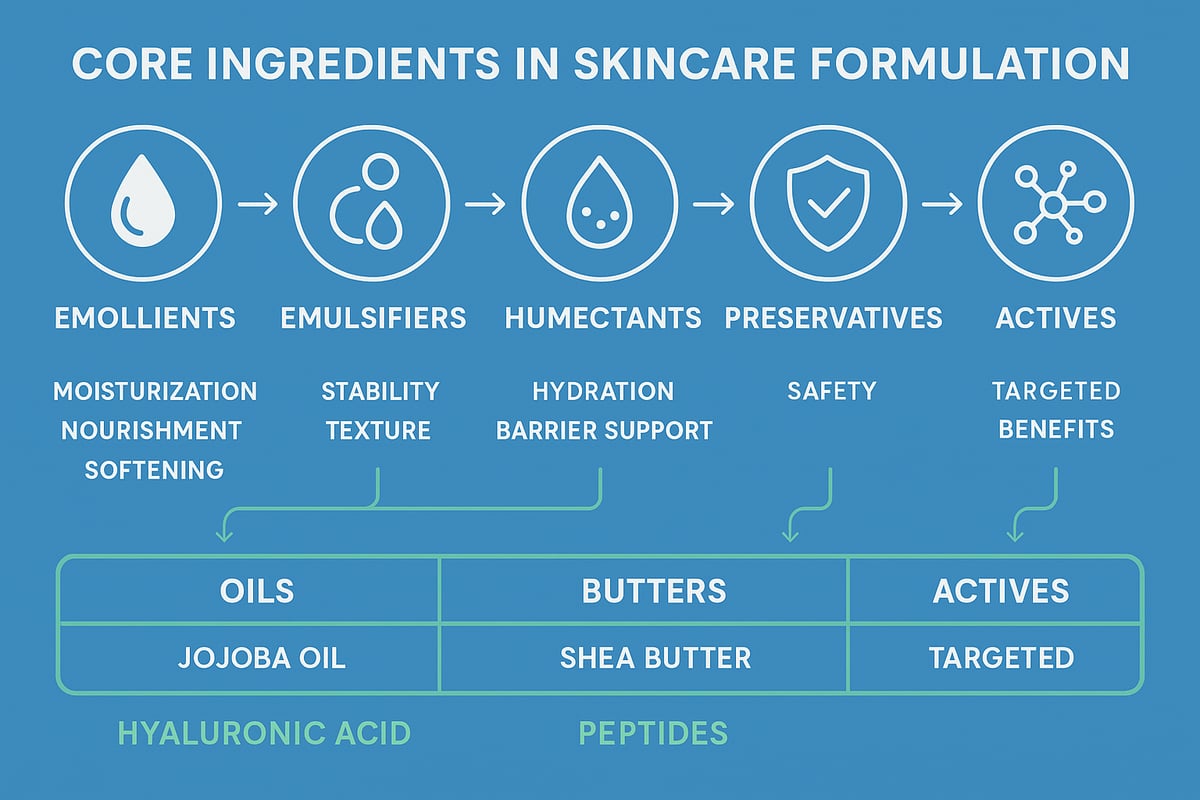
Emollients, Butters, and Oils
Emollients, butters, and oils are the foundation of effective skincare formulation, responsible for moisturizing, softening, and supporting the skin barrier. These ingredients vary in texture and absorption, making it important to select the right type for your target skin type and product texture.
| Ingredient | Key Benefit | Example |
|---|---|---|
| Jojoba Oil | Biomimetic, lightweight | Mimics skin sebum |
| Shea Butter | Rich, nourishing | Deep hydration |
| Rosehip Oil | Fast-absorbing, antioxidant | Brightening effect |
Choosing oils tailored to skin needs enhances user experience and efficacy. In skincare formulation, balancing these ingredients ensures both immediate comfort and lasting protection.
Emulsifiers and Solubilisers
Emulsifiers and solubilisers hold oil and water together, creating stable, homogenous products essential for creams, lotions, and serums. The choice of emulsifier directly impacts the final product’s feel and stability.
Common examples include:
- Olivem 1000 for natural, creamy emulsions
- Lecithin as a gentle, skin-compatible option
- Natural solubilisers for incorporating essential oils
In skincare formulation, using the right emulsifier prevents separation and ensures a smooth, appealing texture. This step is key for both product performance and consumer satisfaction.
Humectants and Hydrators
Humectants and hydrators draw moisture into the skin, making them vital in any skincare formulation aimed at boosting hydration. Popular ingredients like glycerin, hyaluronic acid, and polyglutamic acid work by attracting and retaining water from the environment and deeper skin layers.
Combining humectants with occlusives locks in moisture for longer-lasting results. This pairing is especially effective in serums and moisturizers, providing a balanced approach to skin hydration within modern skincare formulation.
Preservatives and Antimicrobials
Preservatives and antimicrobials are essential for ensuring product safety by preventing microbial growth and extending shelf life. Options like potassium sorbate, benzyl alcohol, and eco-friendly preservation systems are widely used.
Recent industry data shows a decline in preservative-free claims, as safety concerns take priority. Effective preservation is non-negotiable in skincare formulation, protecting both the product and the end user.
Active Ingredients and Exfoliants
Active ingredients and exfoliants target specific skin concerns, delivering visible results in modern skincare formulation. Key actives include peptides for firming, niacinamide for brightening, and acids like AHAs and BHAs for gentle exfoliation.
For example, a formulator’s guide to AHA/BHA use emphasizes safe concentrations and pH levels to avoid irritation. Balancing efficacy with skin tolerance is critical, ensuring actives deliver benefits without compromising comfort. For more on ingredient selection and customization, see How to Choose the Right Skincare Formulation for Your Brand.
Step-by-Step: The Skincare Formulation Process in 2025
Modern skincare formulation requires a precise, iterative process. As consumer expectations rise and regulations evolve, mastering each step is key to developing products that are safe, effective, and future-ready. Whether you are a brand founder, formulator, or enthusiast, this roadmap will guide you through essential actions for 2025.
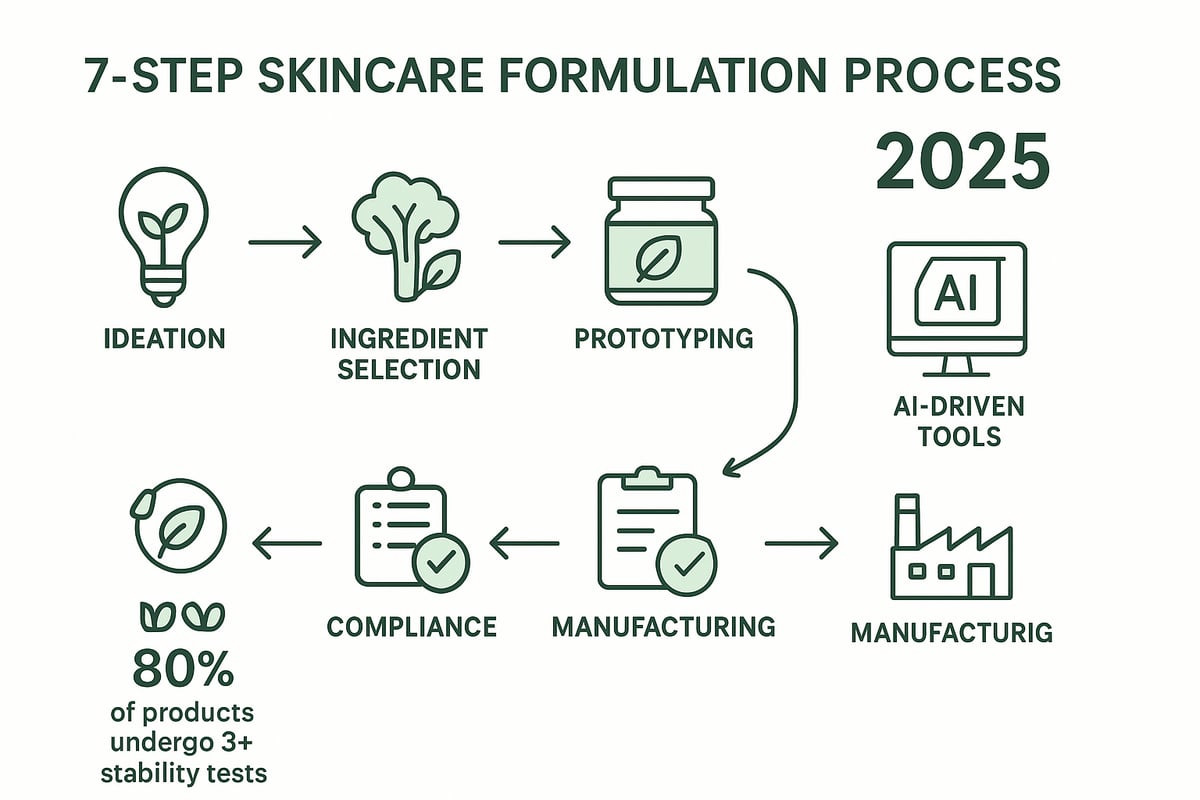
Ideation and Concept Development
Every successful skincare formulation starts with clear intent. Define your target audience and the skin concerns your product addresses. Analyze emerging trends, competitor offerings, and consumer feedback to shape your product vision.
Use surveys, social listening, and market research to pinpoint gaps in the market. For example, rising demand for microbiome-friendly formulas or adaptogenic ingredients may inspire your concept. This foundation ensures your skincare formulation aligns with real needs and stands out in a crowded market. For a detailed guide on structuring your process, explore the Steps to Formulate Safe and Effective Cosmetic Products.
Ingredient Selection and Sourcing
Careful ingredient selection is critical in skincare formulation. Prioritize efficacy, safety, and sustainability. Vet suppliers for transparency, traceability, and ethical practices.
Look for certifications like Fair Trade or Ecocert. Opt for upcycled, biotech-derived, or lab-grown actives when possible. Consider allergen potential and regulatory status for each raw material. By ensuring quality at this stage, you set the foundation for a high-performing skincare formulation that meets both consumer and regulatory expectations.
Formulation Design and Prototyping
Now, translate your concept into a working formula. Use digital formulation software to calculate ingredient percentages and assign ingredients to the appropriate phase (oil, water, active).
Prototyping involves small lab batches of creams, serums, or gels. Test for texture, absorption, and initial stability. Digital tools can simulate ingredient compatibility, helping avoid common pitfalls in skincare formulation. Multiple iterations may be needed to refine the product’s sensorial and functional qualities.
Stability, Safety, and Efficacy Testing
Rigorous testing is vital for any skincare formulation. Conduct stability tests under various conditions: temperature, light, and microbial exposure. This ensures your product maintains safety and performance throughout its shelf life.
Employ patch testing and, where possible, clinical trials to validate efficacy and tolerance. According to industry data, 80% of new products undergo at least three rounds of stability testing. These steps safeguard your brand and build consumer trust in your skincare formulation.
Regulatory Review and Compliance
Navigating global regulations is essential in skincare formulation. Prepare comprehensive safety assessments and regulatory documentation for each market. This includes ingredient lists, allergen labeling, and substantiated product claims.
Stay updated with guidelines from the EU CPNP, FDA VCRP, and APAC authorities. Compliance not only enables market access but also reinforces consumer confidence in your skincare formulation. Keep meticulous records to streamline audits and future updates.
Scaling Up and Manufacturing
Transitioning from lab-scale batches to full production requires careful planning. Collaborate closely with manufacturing partners to maintain batch consistency and quality.
Adopt Good Manufacturing Practice (GMP) protocols to ensure safety and reproducibility at scale. Implement robust quality control checks at every stage. This approach minimizes risk and ensures your skincare formulation delivers consistent results, from the first jar to the thousandth.
Packaging, Labeling, and Launch
Packaging plays both a functional and marketing role in skincare formulation. Select materials that protect your product and align with sustainability goals, such as recyclable or biodegradable options.
Design labels that are informative and regulatory-compliant, including clear ingredient lists and usage instructions. Incorporate QR codes to offer consumers transparency on sourcing and recycling. A well-executed launch strategy ensures your skincare formulation reaches its audience effectively and responsibly.
Innovations Shaping Skincare Formulation in 2025
The landscape of skincare formulation is undergoing a remarkable transformation as we approach 2025. Innovations in science, technology, and sustainability are setting new benchmarks for product efficacy and consumer appeal. Brands are leveraging cutting-edge tools and ingredients to deliver targeted, ethical, and future-ready solutions.

Biotech and Lab-Grown Ingredients
Biotechnology is revolutionizing skincare formulation by enabling the creation of lab-cultured actives that deliver consistent results and minimize environmental impact. Examples include peptides, stem cells, and probiotics that are cultivated in controlled environments.
Fermented hyaluronic acid, produced through precision fermentation, is gaining attention for its enhanced absorption and purity. According to industry data, biotech actives are projected to feature in 40% of new product launches in 2025. This shift not only supports sustainability but also increases the availability of high-performance ingredients.
For a deeper dive into how these breakthroughs are influencing modern skincare formulation, explore the Innovations in Cosmetics blog.
AI and Smart Formulation Tools
Artificial intelligence is emerging as a game-changer in skincare formulation. AI-driven ingredient discovery platforms analyze massive datasets to identify novel actives and optimal combinations. These tools can predict ingredient compatibility, stability, and even potential allergens before physical prototypes are created.
Formulators now use digital prototyping to streamline research and development. This significantly reduces R&D costs and shortens the time to market for new products. As a result, brands can swiftly respond to consumer trends and scientific advancements while maintaining rigorous quality standards.
Microbiome-Focused Formulations
A growing body of research links skin health to the balance of the skin’s microbiota. Skincare formulation in 2025 increasingly prioritizes products that nurture the microbiome, supporting barrier function and reducing sensitivity.
Formulators are incorporating prebiotic and postbiotic ingredients, such as plant-based oligosaccharides and ferments, to foster beneficial bacteria. Microbiome-friendly products address concerns like irritation and dryness, aligning with consumer demand for gentle, science-backed solutions.
Waterless and Minimalist Skincare
Waterless skincare is a leading innovation, offering concentrated formulas in solid, powder, or stick formats. These minimalist products not only reduce packaging waste but also cut the carbon footprint by up to 70% compared to traditional water-based products.
Examples include waterless cleansers, serum sticks, and shampoo bars. This trend in skincare formulation appeals to eco-conscious consumers who value both performance and sustainability. The move toward minimalist routines also supports the desire for simplified, effective daily care.
| Product Type | Carbon Footprint Reduction | Format Examples |
|---|---|---|
| Waterless cleansers | Up to 70% | Solid bars, powders |
| Serum sticks | Up to 70% | Concentrated sticks |
Upcycled and Circular Ingredients
Sustainability is at the forefront of skincare formulation, with brands utilizing upcycled and circular ingredients to minimize waste. This approach repurposes byproducts from food and agriculture, such as grape seed oil from winemaking or fruit enzyme exfoliants.
Circularity not only reduces landfill contributions but also provides unique actives with proven efficacy. Eco-conscious consumers increasingly seek products that champion resourcefulness and environmental responsibility. Upcycled ingredients are becoming a hallmark of innovative, responsible skincare formulation.
Sustainability and Ethical Considerations in Formulation
In 2025, sustainability and ethical responsibility are at the core of skincare formulation. Brands are expected to demonstrate transparency, eco-consciousness, and social accountability at every stage of product development. Let’s explore the essential pillars shaping this landscape.
Ingredient Sourcing and Traceability
Ethical ingredient sourcing is a non-negotiable standard in skincare formulation. Brands now prioritize full traceability, ensuring every raw material is ethically harvested and suppliers uphold responsible practices. Certifications like Fair Trade and Ecocert signal to consumers that a product’s journey is transparent and trustworthy.
Transparency is a market differentiator. Many formulators now document supply chains and share origin stories with their audience. For a deeper dive into natural ingredient strategies and traceable sourcing, explore the Ultimate Guide to Natural Skincare Secrets.
Key certifications:
| Certification | Focus |
|---|---|
| Fair Trade | Ethical labor |
| Ecocert | Organic, eco-safe |
| COSMOS | Natural, organic |
Eco-Friendly Preservation and Packaging
Sustainable skincare formulation extends to preservation systems and packaging choices. Natural preservatives, like plant-based antimicrobials, are gaining traction for their safety and minimal environmental impact. Biodegradable and compostable packaging options, such as plant-based bioplastics, are being adopted to reduce landfill waste.
Consumer preferences are clear: 58% say sustainable packaging influences their purchase decisions. Brands are also using innovative QR codes to share recycling information and ingredient transparency, building trust and loyalty. Sustainable packaging isn’t just a trend, it’s a necessity for forward-thinking brands.
Reducing Environmental Impact
Minimizing the environmental footprint is a key objective in modern skincare formulation. Brands are adopting production methods that use less water and energy, such as cold-process formulations. This not only conserves resources but also reduces overall emissions.
Renewable energy sources and waste reduction strategies, including upcycling byproducts, further enhance sustainability. A lower environmental footprint provides a competitive edge and aligns with growing consumer values. Companies that lead in this area often set themselves apart in a crowded market.
Social Responsibility and Inclusivity
Social responsibility is integral to the success of any skincare formulation brand. Ethical practices include ensuring fair labor conditions, supporting local communities, and fostering diversity throughout the supply chain. Product development should address the needs of all consumers, offering inclusive shade ranges and gender-neutral options.
Inclusivity is not just about marketing, it’s about meaningful representation in product design and company culture. Brands that embrace these values build stronger relationships with their customers and contribute positively to society.
The Future of Skincare Formulation: Trends and Predictions
As 2025 approaches, the future of skincare formulation is defined by rapid innovation and shifting consumer expectations. Brands and formulators must adapt to a landscape where personalization, technology, safety, and transparency are the new standards. Let us examine the trends shaping tomorrow’s skincare science.
Personalized and Adaptive Skincare
Personalization is at the forefront of skincare formulation trends. AI-driven diagnostics, custom blends, and at-home analysis tools are transforming how individuals select products. The shift is propelled by consumer demand for solutions tailored to unique skin needs and lifestyles.
Recent projections show the personalized skincare market growth is expected to reach $12 billion by 2025, reflecting increased investment in adaptive technologies. Skincare formulation now involves collecting real-time data, analyzing skin conditions, and crafting ingredient profiles that evolve with each user. This approach not only elevates results but also builds deeper consumer trust.
Advanced Delivery Systems
Delivery technology is revolutionizing skincare formulation, making active ingredients more effective and safer for the skin. Encapsulation, nanotechnology, and transdermal patches are among the leading innovations. These systems allow for precise, time-release distribution of actives, ensuring sustained efficacy and minimizing irritation.
Formulators are leveraging these advancements to overcome challenges like ingredient instability or poor absorption. For example, encapsulated retinol can be delivered slowly to reduce sensitivity, while nanoliposomes enhance penetration of hydrating agents. As delivery systems advance, skincare formulation becomes more targeted and results-driven.
| Delivery System | Benefit | Example Use Case |
|---|---|---|
| Encapsulation | Time-release actives | Retinol serums |
| Nanotechnology | Enhanced penetration | Vitamin C creams |
| Transdermal Patch | Controlled dosing | Peptide treatments |
Regulatory and Safety Advances
The regulatory landscape for skincare formulation is evolving rapidly. In 2025, brands must navigate updates in global safety standards, ingredient restrictions, and harmonized labeling requirements. These changes aim to protect consumers, ensure transparency, and support global market access.
Greater scrutiny is placed on allergen disclosure, preservative limits, and substantiated claims. Regulatory agility is now a key advantage, as brands that adapt quickly can maintain compliance and consumer trust. Staying informed and proactive in safety assessments is essential for success in skincare formulation.
Consumer Education and Transparency
Modern consumers demand ingredient literacy and open communication from skincare brands. Interactive databases, transparent sourcing information, and digital ingredient glossaries are becoming standard features. Before purchasing, 72% of consumers research ingredients, underscoring the importance of accessible, credible information.
This trend drives brands to prioritize clear labeling, honest marketing, and direct engagement with their audiences. By educating consumers and offering full transparency, companies position themselves as trusted leaders in skincare formulation and foster lasting loyalty.
As you’ve discovered throughout this guide, skincare formulation in 2025 is all about innovation, sustainability, and meeting evolving consumer expectations. Whether you’re an entrepreneur ready to launch your first product or an established brand refining your next breakthrough, every detail—from ingredient selection to ethical sourcing—matters. If you’re inspired to take the next step and create a standout, high-performance formula with full support at every stage, I invite you to Start Your Product Journey. Together, we can turn your vision into a truly exceptional product that resonates in tomorrow’s market.
